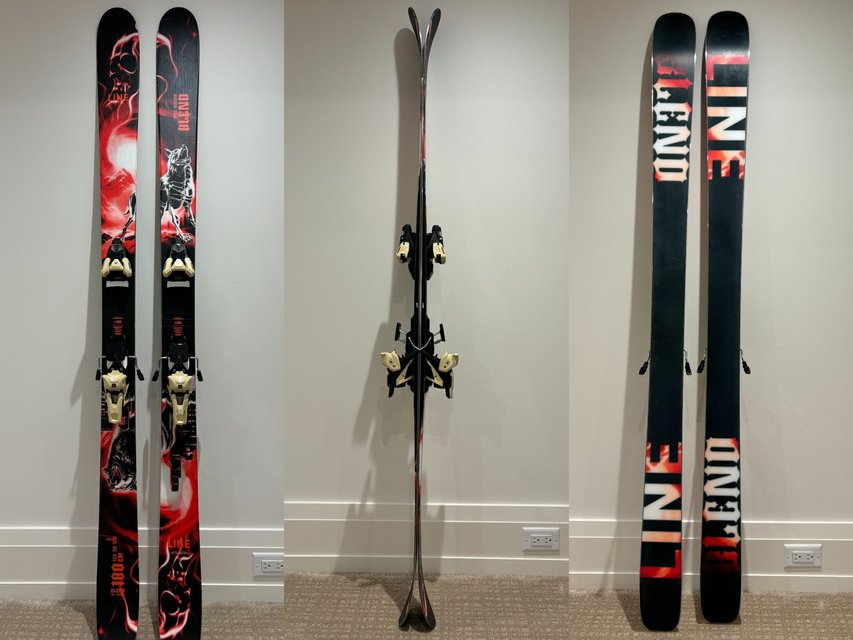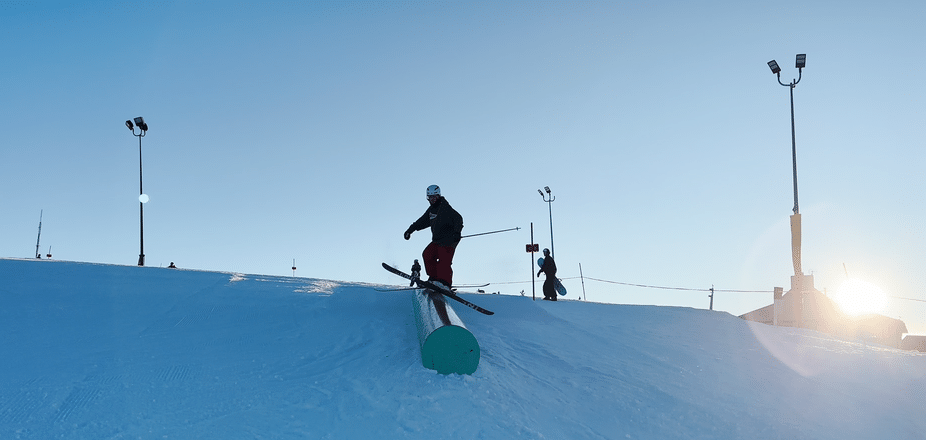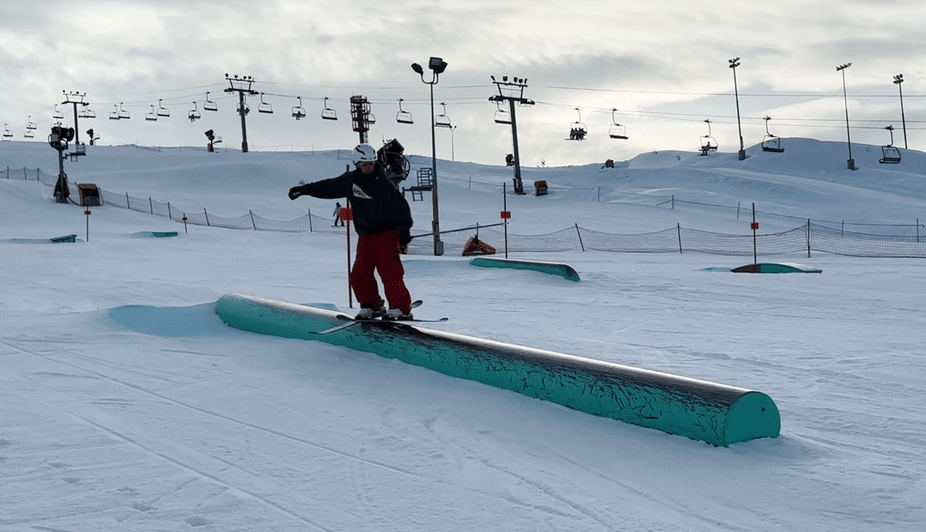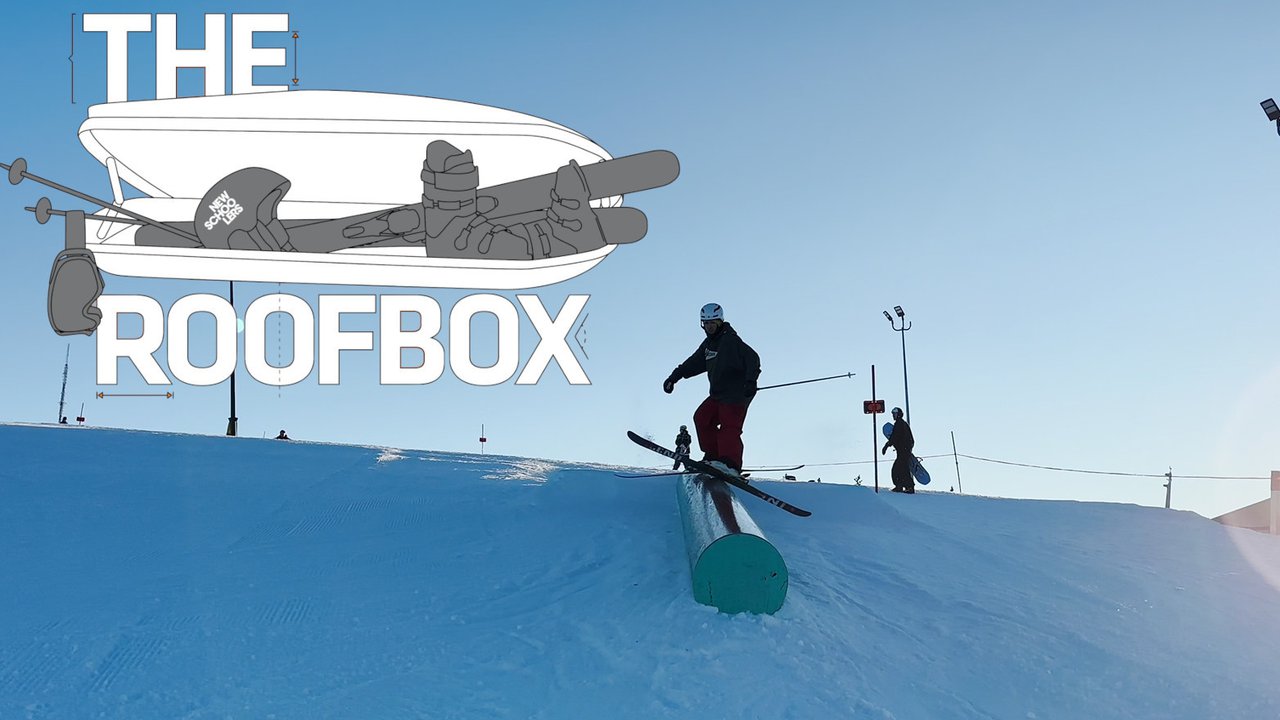Ski: Line Blend WW 180
Reviewer height/Weight: 5’9 / 160 lbs
Dimensions: 128-98-120
Weight: 1850g
Radius: 20m
True Length: 181.5 cm
Mount Point: -1.5cm
Terrain Skied: Early season park
_
The Line Blend WW is Will Wesson’s long-deserved first pro model ski. It's designed for the kind of skiing he likes, namely, technical rail skiing with unconventional tricks. As such, they are a soft, wide park ski with a very low swingweight. The first thing that I noticed when I unboxed these skis was the graphic. The wolves, skull-clouds, and gothic buildings felt like a throwback to the golden age of Line graphics in the late 2000s and early 2010s, and considering that’s what was in fashion when I came up skiing park, I was stoked to see it.
_
Shape/Flex/Construction:
There have been a number of changes made from the outgoing model of the Blend, they are 2mm narrower underfoot, with the tips being made 5mm narrower. There is also a new construction borrowed from the Chronic and Bacon lines, with thick vertical sidewalls underfoot and Thin Tips where the base and topsheet are directly bonded to each other. These changes give the skis a reduced swingweight, and hopefully, improved durability from the previous Blends.

The second you get these in hand, you realize one thing. These skis are soft. Seriously soft. I was able to flex these skis closer to the center than I usually can with a park ski, and the tips and tails will bend with very little effort. The previous generation of Blends was known as one of the softest production skis available, and I was happy to see that hasn’t changed.
The sidewall underfoot is substantial and vertical, narrowing out a bit towards the tips. The sidewalls look very solid, and make me think that these skis should hold up to some abuse, and will be (somewhat) more stable than their soft flex would have you think. The tip construction (which I have experience riding on my Bacon 108s) does a great job of reducing swing weight, so I’m sure that the Blends will be easy to spin.
_
On snow (Park):

I got these in the mail right at the start of December, which is still quite early in the season in Alberta, so most of my time was spent on tubes and one very small jump line. This could be described as the Blend’s native habitat, and they felt great on the small features I had available to me. They are quite lightweight, and in combination with this new model’s narrowed tips (6mm less than the outgoing model), and their new construction they were nimble when doing switch-ups and spins onto rails. In spite of these skis probably being a bit too big for me (they are listed as 180s, but were considerably longer than my 182 Icelantics), I had no problem when trying some more technical tricks. Even when doing tricks like illusives and 2-ons to switch up combos, these skis kept up with my feet, and I was able to spin 450s out of rails no more than a foot off of the ground. I can understand why these are the rail skis of choice for much of Line’s team. With their soft flex, wide platform, and mellow rocker and camber, they felt very smooth while grinding, and made a stable platform for 5050s and other unconventional rail tricks. Definitely a great choice both for those looking to get weird on rails, and for those looking to do tech rail tricks.

Our biggest jump was no larger than 10 feet, and these skis were more than stable enough for the modest impact that those jumps provided, even when going deep into the landing on some 360s and 540s. This has no impact on performance, but these skis made a great big “WHAP” sound on every landing like an old pair of floppy pow skis, which I enjoyed a lot. In my opinion, skis this soft feel great on jumps, smoother and more predictable than stiff park skis, but they do require you to land pretty proper or you’ll risk wheelieing out or going over your tips, and the Blends have very little support in their tips and tails if you do end up there. But this only happened to me once in a week of skiing, and these skis are solid enough underfoot to handle typical park features if you land well. These skis are not a great choice for people who like going huge (unless you’re Bennie Osnow), but they held up to what I could throw at them on our smaller features.

Buttering these required a big adjustment from my usual technique. The last skis I rode were Icelantic Nomad 94s, which I wouldn’t call stiff, but are nowhere near as soft as the Blends. Buttering them required some speed and force, and so out of habit, that’s how I approached my first butter on the Blends. I ended up overflexing them and needing to put my hands down to prevent a faceplant. The next few times I went slower, and put less and less force into initiating the butter, and was eventually able to find the sweet spot. It was much easier to hold butters on the Blends than on any ski I’d tried before, and I was able to do some long butter 3s down the hill and some very deep butters off of rollers. I prefer a stiffer ski for launching high speed butters off of knuckles or jumps, but these skis allow you to butter more easily on just about anything else, and I think that people looking to do low speed butter tricks, and real butters (none of that revert stuff) onto rails would really enjoy these skis.
_
Comparisons:
Vs Line Bacon 108:
Out of all of the skis I’ve ridden in the past few years, the Bacons feel most similar to the Blends. They share a very similar construction and flex, and have the same buttery, loose feel in the park. There are a number of important differences in their performance however, with the Bacons being considerably heavier (around 400g difference in the same size) and wider than the Blends. This makes the Bacons a more stable platform for jumps, but comes at the cost of some quickness on rails, and the extra weight can be tiring during long sessions. The Bacon’s swingweight is not bad, but the Blends felt very light. Of course, this is only considering their performance in the park. The Bacon will make a much better all mountain / powder ski with their wider profile and higher stability, but most people looking for a dedicated park ski should opt for Blends.
Armada Edollo:
These skis appear similar on paper, both having 98mm underfoot widths, rocker, and a reputation for being buttery, but they feel very different to ski. Edollos are stiffer, especially in the tail, and don’t have rocker in the tails making them a far more stable ski on jumps, and their heavier weight and lack of swingweight reducing Thin Tips make them feel slower to spin. Both are playful and fun to ride, but I think that the Blends, with their light swing weight and softer flex would be preferred by people who primarily ski rails and aren’t looking to hit large jumps. Edollos also take some more force to initiate butters on (at least until you’ve broken them in), whereas I think just about anyone could put a deep bend into the Blends.
_
Durability:
After 7 days of skiing, I have no noticeable damage to the bases or edges, and only a little sidewall chipping on the tips, so far they are looking good. My general experience of this new Line construction is that it is much better than older models.
_
Conclusion:
I enjoyed my time in the pre-season parks on the Blends, and I thought that they made a very fun, and very easy to ride park ski. Between their soft flex, low weight, and even lower swingweight, they are an excellent ski for those looking to get tech (or weird) on rails, but those same qualities make them less than ideal for big jumps. While I personally enjoy skiing soft skis on jumps, people who are looking to really push themselves, or go huge, would appreciate a ski with (a lot) more support than the Blend WWs. However, for anyone who mainly focuses on rails, or doesn’t mind a soft ski on jumps, I think these skis are a great choice.
Because I had very limited terrain available to me at the time of writing, I plan on making an update to this review in the coming months after I get to ride these skis on some bigger features and around the resort, so keep an eye out for that.
https://www.newschoolers.com/videos/watch/1103244/My-Movie-1-mov


Comments